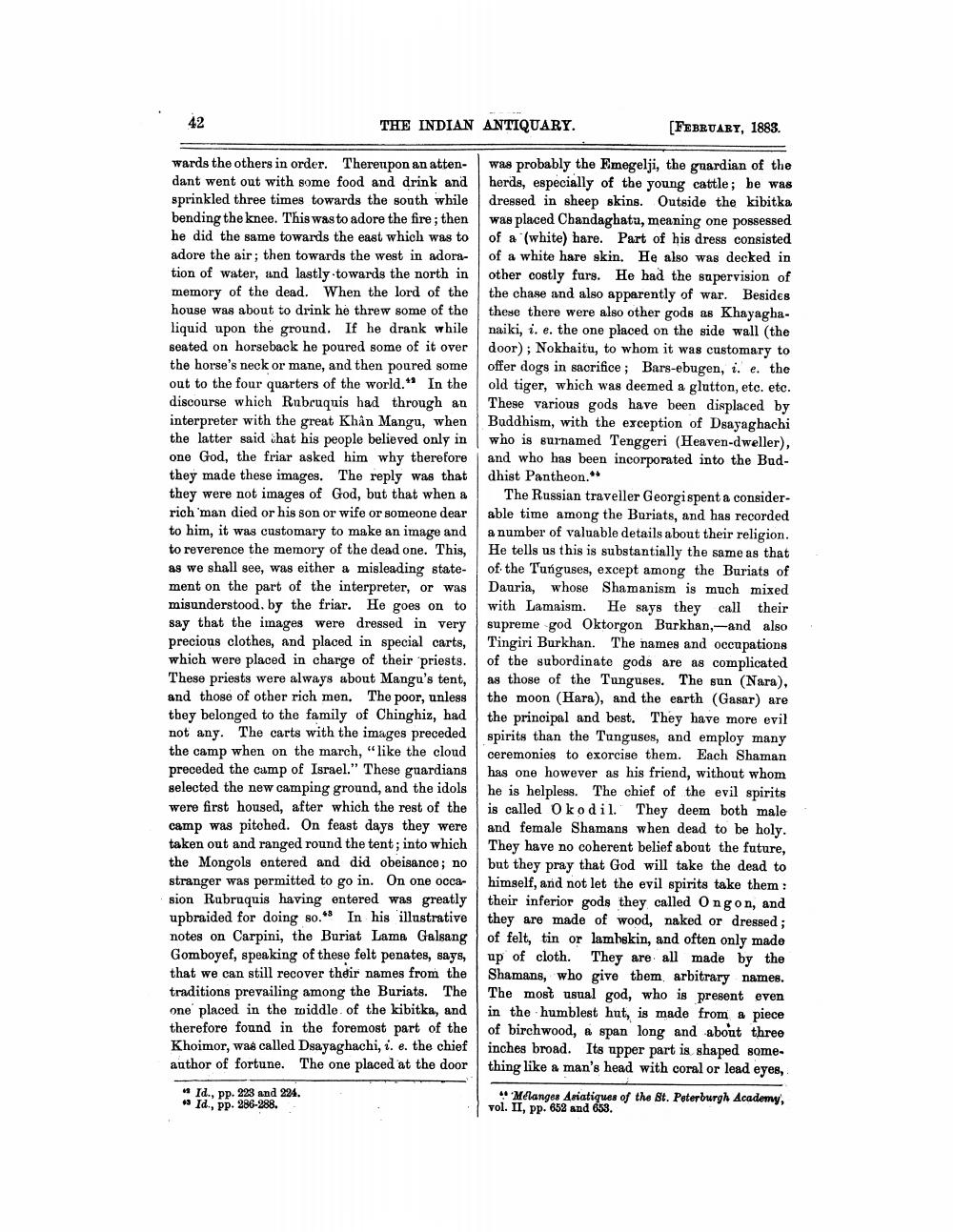________________
42
THE INDIAN ANTIQUARY.
FEBRUARY, 1883
wards the others in order. Thereupon an attendant went out with some food and drink and sprinkled three times towards the south while bending the knee. This was to adore the fire; then he did the same towards the east which was to adore the air; then towards the west in adora- tion of water, and lastly towards the north in memory of the dead. When the lord of the house was about to drink he threw some of the liquid upon the ground. If he drank while seated on horseback he poured some of it over the horse's neck or mane, and then poured some out to the four quarters of the world." In the discourse which Rubruquis had through an interpreter with the great Khan Mangu, when the latter said what his people believed only in one God, the friar asked him why therefore they made these images. The reply was that they were not images of God, but that when a rich 'man died or his son or wife or someone dear to him, it was customary to make an image and to reverence the memory of the dead one. This, as we shall see, was either a misleading statement on the part of the interpreter, or was misunderstood. by the friar. He goes on to say that the images were dressed in very precious clothes, and placed in special carts, which were placed in charge of their priests. These priests were always about Mangu's tent, and those of other rich men. The poor, unless they belonged to the family of Chinghiz, had not any. The carts with the images preceded the camp when on the march, "like the cloud preceded the camp of Israel." These guardians selected the new camping ground, and the idols were first housed, after which the rest of the camp was pitohed. On feast days they were taken out and ranged round the tent; into which the Mongols entered and did obeisance; no stranger was permitted to go in. On one occasion Rubruquis having entered was greatly upbraided for doing so." In his illustrative notes on Carpini, the Buriat Lama Galsang Gomboyef, speaking of these felt penates, says, that we can still recover their names from the traditions prevailing among the Buriats. The one placed in the toiddle of the kibitka, and therefore found in the foremost part of the Khoimor, was called Dsayaghachi, i. e. the chief author of fortune. The one placed at the door
was probably the Emegelji, the guardian of the herds, especially of the young cattle; be was dressed in sheep skins. Outside the kibitka was placed Chandaghata, meaning one possessed of a (white) hare. Part of his dress consisted of a white hare skin. He also was decked in other costly furg. He had the supervision of the chase and also apparently of war. Besides these there were also other gods as Khayaghanaiki, i.e. the one placed on the side wall (the door), Nokhaitu, to whom it was customary to offer dogs in sacrifice ; Bars-ebugen, i. e. the old tiger, which was deemed a glutton, etc. etc. These various gods have been displaced by Buddhism, with the exception of Dsayaghachi who is surnamed Tenggeri (Heaven-dweller), and who has been incorporated into the Buddhist Pantheon."
The Russian traveller Georgispent a considerable time among the Buriats, and has recorded a number of valuable details about their religion. He tells us this is substantially the same as that of the Tunguses, except among the Buriats of Dauria, whose Shamanism is much mixed with Lamaism. He says they call their supreme god Oktorgon Burkhan,--and also Tingiri Burkhan. The names and occupations of the subordinate gods are as complicated as those of the Tunguses. The sun (Nara), the moon (Hara), and the earth (Gasar) are the principal and best. They have more evil spirits than the Tunguses, and employ many ceremonies to exorcise them. Each Shaman has one however as his friend, without whom he is helpless. The chief of the evil spirits is called O kodil. They deem both male and female Shamans when dead to be holy. They have no coherent belief about the future, but they pray that God will take the dead to himself, and not let the evil spirits take them : their inferior gods they called Ongon, and they are made of wood, naked or dressed; of felt, tin or lambskin, and often only made up of cloth. They are all made by the Shamans, who give them arbitrary names. The most usual god, who is present even in the humblest hat, is made from a piece of birchwood, a span long and about three inches broad. Its upper part is shaped something like a man's head with coral or lead eyes,
Mélanges Asiatiques of the St. Peterburgh Academy, vol. II, pp. 652 and 653.
* Id., pp. 223 and 224. * Id., PP. 286-288.




